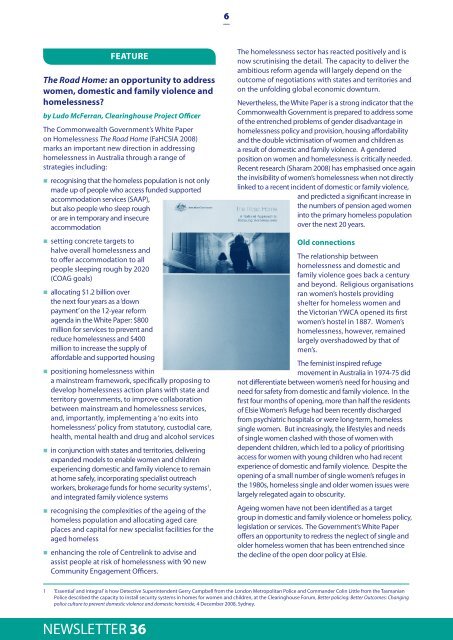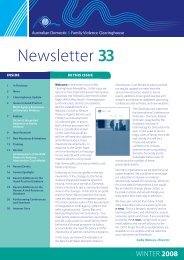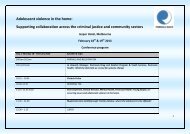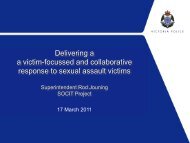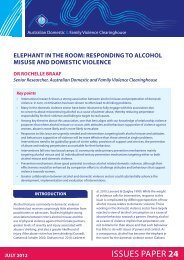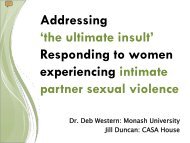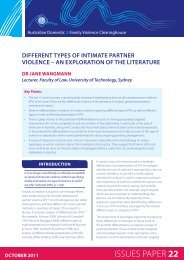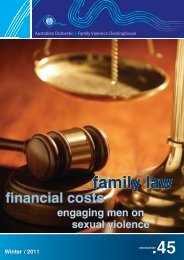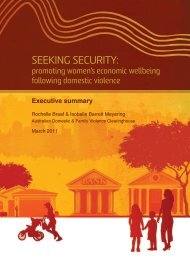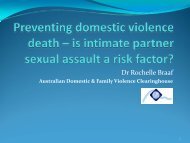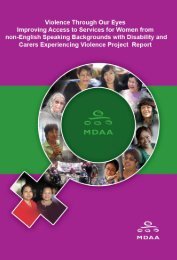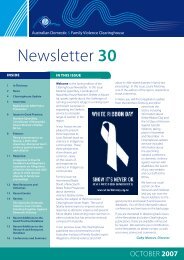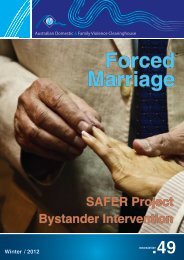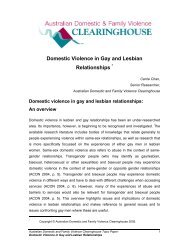newsletter - Australian Domestic and Family Violence Clearing House
newsletter - Australian Domestic and Family Violence Clearing House
newsletter - Australian Domestic and Family Violence Clearing House
You also want an ePaper? Increase the reach of your titles
YUMPU automatically turns print PDFs into web optimized ePapers that Google loves.
6<br />
FEATURE<br />
The Road Home: an opportunity to address<br />
women, domestic <strong>and</strong> family violence <strong>and</strong><br />
homelessness<br />
by Ludo McFerran, <strong>Clearing</strong>house Project Officer<br />
The Commonwealth Government’s White Paper<br />
on Homelessness The Road Home (FaHCSIA 2008)<br />
marks an important new direction in addressing<br />
homelessness in Australia through a range of<br />
strategies including:<br />
•recognising that the homeless population is not only<br />
made up of people who access funded supported<br />
accommodation services (SAAP),<br />
but also people who sleep rough<br />
or are in temporary <strong>and</strong> insecure<br />
accommodation<br />
•setting concrete targets to<br />
halve overall homelessness <strong>and</strong><br />
to offer accommodation to all<br />
people sleeping rough by 2020<br />
(COAG goals)<br />
•allocating $1.2 billion over<br />
the next four years as a ‘down<br />
payment’ on the 12-year reform<br />
agenda in the White Paper: $800<br />
million for services to prevent <strong>and</strong><br />
reduce homelessness <strong>and</strong> $400<br />
million to increase the supply of<br />
affordable <strong>and</strong> supported housing<br />
•positioning homelessness within<br />
a mainstream framework, specifically proposing to<br />
develop homelessness action plans with state <strong>and</strong><br />
territory governments, to improve collaboration<br />
between mainstream <strong>and</strong> homelessness services,<br />
<strong>and</strong>, importantly, implementing a ‘no exits into<br />
homelessness’ policy from statutory, custodial care,<br />
health, mental health <strong>and</strong> drug <strong>and</strong> alcohol services<br />
•in conjunction with states <strong>and</strong> territories, delivering<br />
exp<strong>and</strong>ed models to enable women <strong>and</strong> children<br />
experiencing domestic <strong>and</strong> family violence to remain<br />
at home safely, incorporating specialist outreach<br />
workers, brokerage funds for home security systems 1 ,<br />
<strong>and</strong> integrated family violence systems<br />
•recognising the complexities of the ageing of the<br />
homeless population <strong>and</strong> allocating aged care<br />
places <strong>and</strong> capital for new specialist facilities for the<br />
aged homeless<br />
•enhancing the role of Centrelink to advise <strong>and</strong><br />
assist people at risk of homelessness with 90 new<br />
Community Engagement Officers.<br />
The homelessness sector has reacted positively <strong>and</strong> is<br />
now scrutinising the detail. The capacity to deliver the<br />
ambitious reform agenda will largely depend on the<br />
outcome of negotiations with states <strong>and</strong> territories <strong>and</strong><br />
on the unfolding global economic downturn.<br />
Nevertheless, the White Paper is a strong indicator that the<br />
Commonwealth Government is prepared to address some<br />
of the entrenched problems of gender disadvantage in<br />
homelessness policy <strong>and</strong> provision, housing affordability<br />
<strong>and</strong> the double victimisation of women <strong>and</strong> children as<br />
a result of domestic <strong>and</strong> family violence. A gendered<br />
position on women <strong>and</strong> homelessness is critically needed.<br />
Recent research (Sharam 2008) has emphasised once again<br />
the invisibility of women’s homelessness when not directly<br />
linked to a recent incident of domestic or family violence,<br />
<strong>and</strong> predicted a significant increase in<br />
the numbers of pension aged women<br />
into the primary homeless population<br />
over the next 20 years.<br />
Old connections<br />
The relationship between<br />
homelessness <strong>and</strong> domestic <strong>and</strong><br />
family violence goes back a century<br />
<strong>and</strong> beyond. Religious organisations<br />
ran women’s hostels providing<br />
shelter for homeless women <strong>and</strong><br />
the Victorian YWCA opened its first<br />
women’s hostel in 1887. Women’s<br />
homelessness, however, remained<br />
largely overshadowed by that of<br />
men’s.<br />
The feminist inspired refuge<br />
movement in Australia in 1974-75 did<br />
not differentiate between women’s need for housing <strong>and</strong><br />
need for safety from domestic <strong>and</strong> family violence. In the<br />
first four months of opening, more than half the residents<br />
of Elsie Women’s Refuge had been recently discharged<br />
from psychiatric hospitals or were long-term, homeless<br />
single women. But increasingly, the lifestyles <strong>and</strong> needs<br />
of single women clashed with those of women with<br />
dependent children, which led to a policy of prioritising<br />
access for women with young children who had recent<br />
experience of domestic <strong>and</strong> family violence. Despite the<br />
opening of a small number of single women’s refuges in<br />
the 1980s, homeless single <strong>and</strong> older women issues were<br />
largely relegated again to obscurity.<br />
Ageing women have not been identified as a target<br />
group in domestic <strong>and</strong> family violence or homeless policy,<br />
legislation or services. The Government’s White Paper<br />
offers an opportunity to redress the neglect of single <strong>and</strong><br />
older homeless women that has been entrenched since<br />
the decline of the open door policy at Elsie.<br />
1 ‘Essential’ <strong>and</strong> integral’ is how Detective Superintendent Gerry Campbell from the London Metropolitan Police <strong>and</strong> Comm<strong>and</strong>er Colin Little from the Tasmanian<br />
Police described the capacity to install security systems in homes for women <strong>and</strong> children, at the <strong>Clearing</strong>house Forum, Better policing: Better Outcomes: Changing<br />
police culture to prevent domestic violence <strong>and</strong> domestic homicide, 4 December 2008, Sydney.<br />
<strong>newsletter</strong> 36


